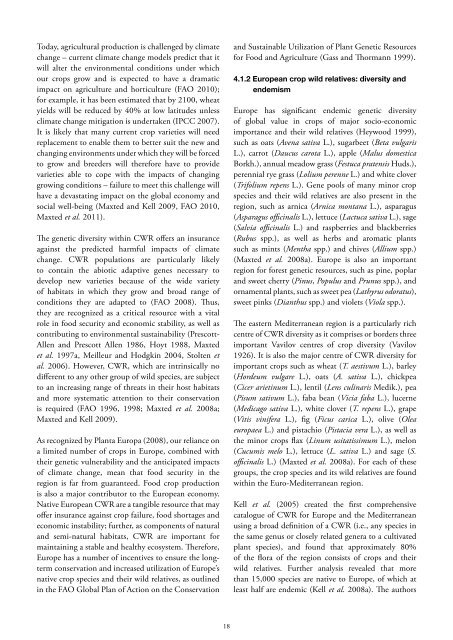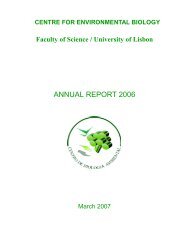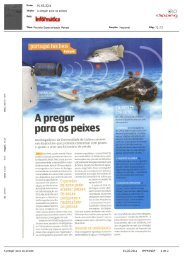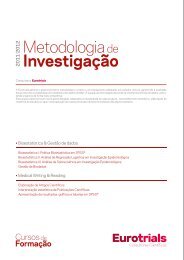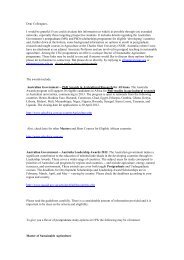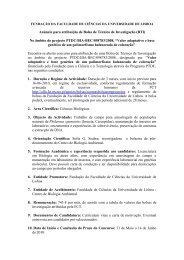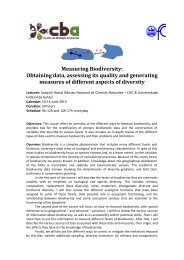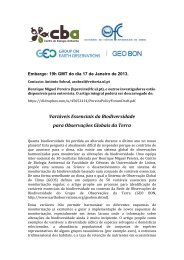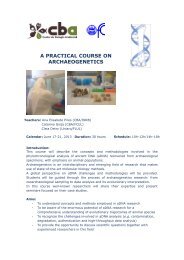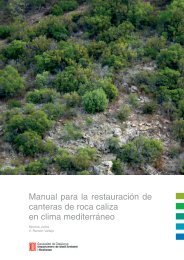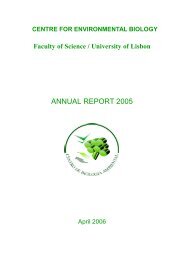European Red List of Vascular Plants - European Commission
European Red List of Vascular Plants - European Commission
European Red List of Vascular Plants - European Commission
You also want an ePaper? Increase the reach of your titles
YUMPU automatically turns print PDFs into web optimized ePapers that Google loves.
Today, agricultural production is challenged by climate<br />
change – current climate change models predict that it<br />
will alter the environmental conditions under which<br />
our crops grow and is expected to have a dramatic<br />
impact on agriculture and horticulture (FAO 2010);<br />
for example, it has been estimated that by 2100, wheat<br />
yields will be reduced by 40% at low latitudes unless<br />
climate change mitigation is undertaken (IPCC 2007).<br />
It is likely that many current crop varieties will need<br />
replacement to enable them to better suit the new and<br />
changing environments under which they will be forced<br />
to grow and breeders will therefore have to provide<br />
varieties able to cope with the impacts <strong>of</strong> changing<br />
growing conditions – failure to meet this challenge will<br />
have a devastating impact on the global economy and<br />
social well-being (Maxted and Kell 2009, FAO 2010,<br />
Maxted et al. 2011).<br />
The genetic diversity within CWR <strong>of</strong>fers an insurance<br />
against the predicted harmful impacts <strong>of</strong> climate<br />
change. CWR populations are particularly likely<br />
to contain the abiotic adaptive genes necessary to<br />
develop new varieties because <strong>of</strong> the wide variety<br />
<strong>of</strong> habitats in which they grow and broad range <strong>of</strong><br />
conditions they are adapted to (FAO 2008). Thus,<br />
they are recognized as a critical resource with a vital<br />
role in food security and economic stability, as well as<br />
contributing to environmental sustainability (Prescott-<br />
Allen and Prescott Allen 1986, Hoyt 1988, Maxted<br />
et al. 1997a, Meilleur and Hodgkin 2004, Stolten et<br />
al. 2006). However, CWR, which are intrinsically no<br />
different to any other group <strong>of</strong> wild species, are subject<br />
to an increasing range <strong>of</strong> threats in their host habitats<br />
and more systematic attention to their conservation<br />
is required (FAO 1996, 1998; Maxted et al. 2008a;<br />
Maxted and Kell 2009).<br />
As recognized by Planta Europa (2008), our reliance on<br />
a limited number <strong>of</strong> crops in Europe, combined with<br />
their genetic vulnerability and the anticipated impacts<br />
<strong>of</strong> climate change, mean that food security in the<br />
region is far from guaranteed. Food crop production<br />
is also a major contributor to the <strong>European</strong> economy.<br />
Native <strong>European</strong> CWR are a tangible resource that may<br />
<strong>of</strong>fer insurance against crop failure, food shortages and<br />
economic instability; further, as components <strong>of</strong> natural<br />
and semi-natural habitats, CWR are important for<br />
maintaining a stable and healthy ecosystem. Therefore,<br />
Europe has a number <strong>of</strong> incentives to ensure the longterm<br />
conservation and increased utilization <strong>of</strong> Europe’s<br />
native crop species and their wild relatives, as outlined<br />
in the FAO Global Plan <strong>of</strong> Action on the Conservation<br />
and Sustainable Utilization <strong>of</strong> Plant Genetic Resources<br />
for Food and Agriculture (Gass and Thormann 1999).<br />
4.1.2 <strong>European</strong> crop wild relatives: diversity and<br />
endemism<br />
Europe has significant endemic genetic diversity<br />
<strong>of</strong> global value in crops <strong>of</strong> major socio-economic<br />
importance and their wild relatives (Heywood 1999),<br />
such as oats (Avena sativa L.), sugarbeet (Beta vulgaris<br />
L.), carrot (Daucus carota L.), apple (Malus domestica<br />
Borkh.), annual meadow grass (Festuca pratensis Huds.),<br />
perennial rye grass (Lolium perenne L.) and white clover<br />
(Trifolium repens L.). Gene pools <strong>of</strong> many minor crop<br />
species and their wild relatives are also present in the<br />
region, such as arnica (Arnica montana L.), asparagus<br />
(Asparagus <strong>of</strong>ficinalis L.), lettuce (Lactuca sativa L.), sage<br />
(Salvia <strong>of</strong>ficinalis L.) and raspberries and blackberries<br />
(Rubus spp.), as well as herbs and aromatic plants<br />
such as mints (Mentha spp.) and chives (Allium spp.)<br />
(Maxted et al. 2008a). Europe is also an important<br />
region for forest genetic resources, such as pine, poplar<br />
and sweet cherry (Pinus, Populus and Prunus spp.), and<br />
ornamental plants, such as sweet pea (Lathyrus odoratus),<br />
sweet pinks (Dianthus spp.) and violets (Viola spp.).<br />
The eastern Mediterranean region is a particularly rich<br />
centre <strong>of</strong> CWR diversity as it comprises or borders three<br />
important Vavilov centres <strong>of</strong> crop diversity (Vavilov<br />
1926). It is also the major centre <strong>of</strong> CWR diversity for<br />
important crops such as wheat (T. aestivum L.), barley<br />
(Hordeum vulgare L.), oats (A. sativa L.), chickpea<br />
(Cicer arietinum L.), lentil (Lens culinaris Medik.), pea<br />
(Pisum sativum L.), faba bean (Vicia faba L.), lucerne<br />
(Medicago sativa L.), white clover (T. repens L.), grape<br />
(Vitis vinifera L.), fig (Ficus carica L.), olive (Olea<br />
europaea L.) and pistachio (Pistacia vera L.), as well as<br />
the minor crops flax (Linum usitatissimum L.), melon<br />
(Cucumis melo L.), lettuce (L. sativa L.) and sage (S.<br />
<strong>of</strong>ficinalis L.) (Maxted et al. 2008a). For each <strong>of</strong> these<br />
groups, the crop species and its wild relatives are found<br />
within the Euro-Mediterranean region.<br />
Kell et al. (2005) created the first comprehensive<br />
catalogue <strong>of</strong> CWR for Europe and the Mediterranean<br />
using a broad definition <strong>of</strong> a CWR (i.e., any species in<br />
the same genus or closely related genera to a cultivated<br />
plant species), and found that approximately 80%<br />
<strong>of</strong> the flora <strong>of</strong> the region consists <strong>of</strong> crops and their<br />
wild relatives. Further analysis revealed that more<br />
than 15,000 species are native to Europe, <strong>of</strong> which at<br />
least half are endemic (Kell et al. 2008a). The authors<br />
18


